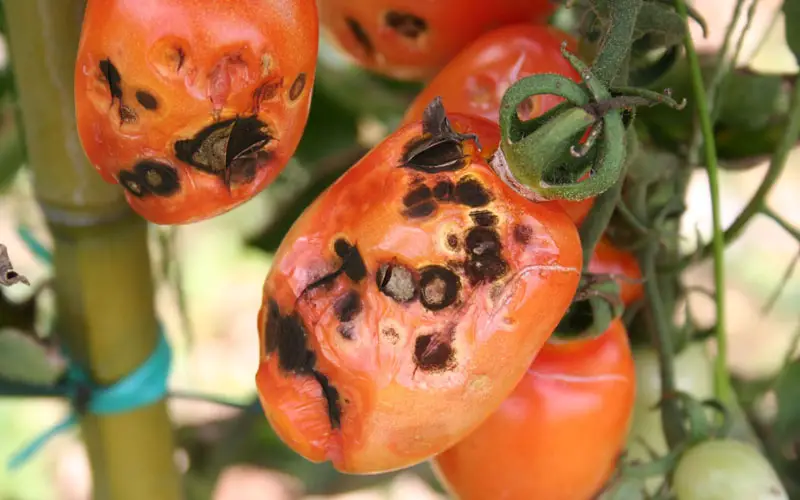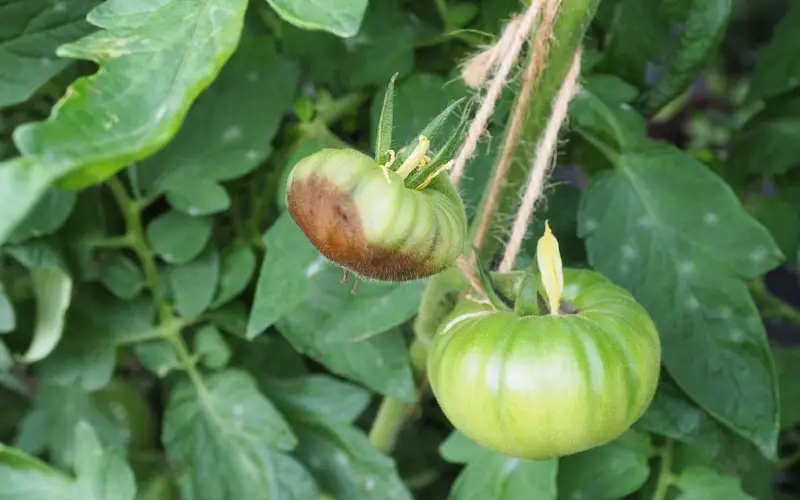Several diseases can attack our plants, fruits and flowers, but not all of them have treatment.
It is so disappointing to see the growing tomatoes getting damaged by different insects or diseases. Also, can be so overwhelming if you see a problem and you don’t know how to fix it.
This article will be about only one problem, its causes and treatments: the mysterious black spots on tomato fruits.

They are not really a mystery, and not a disease either. Black spots on your tomatoes are more a physiological condition.
If you see a tomato in mid-growth having black spots that are starting from the blossom end of the tomato fruits, then you see the classic symptom of blossom-end rot.
Blossom-end rot is a common problem, usually in the first flush of fruits and in the fruits that are not fully grown yet.
What is Blossom-End Rot?
Blossom-end rot is a common problem not only in tomatoes but peppers, cucumbers, aubergines and melons as well.
This is not a disease, but a physiological condition or disorder, that is caused by the lack of calcium in the plant.
The brownish, black and sunken spots develop at the bottom of the fruits, where the flower was once.
Blossom-end rot can appear in any garden, but mostly in greenhouses or on tomatoes that are grown in growing bags that are not watered properly.
What Causes Blossom End Rot?
Blossom-end rot is related to the condition of the roots.
I am saying this because this damage in the fruits appears when the plant is lacking in Calcium.
So, the roots are responsible to absorb the nutrients and then deliver to the plant.
If the roots are unhealthy, they will be unable to absorb the needed Calcium and the whole plant and the fruits will lack energy.
Now, let’s see what are factors that can compromise the tomato plant’s root system and then cause blossom-end rot.
Watering
Inconsistent watering is the most common source of blossom-end rot. A tomato plant needs in general 1 inch/ 2,5 cm of water every week.
You might ask now why I am telling you this. Because Calcium needs water and healthy roots to get to its destination.
If you underwater your tomatoes, there won’t be enough water for the roots to absorb the Calcium.
On the other hand, too much water isn’t good either because this can cause root rot; therefore, the rooting system will be damaged and will not be able to deliver the Calcium.
In conclusion, you must keep your tomatoes’ soil evenly moist and avoid fluctuation with watering.
Soil
A soil that is too acidic or too alkaline can be another cause of Calcium deficiency and blossom-end rot.
The optimal soil pH for tomatoes is somewhere between 6.2-6.8. This helps the tomato plants’ root system to absorb Calcium much easier.
Fertilizing
As tomatoes are heavy feeders, it is good to fertilize them regularly. However, you must use the proper fertilizer and use it as directed.
Over-fertilizing, or not using the right fertilizer, that is made for tomatoes, can lead to Calcium deficiency.
Too much nitrogen can tie up Calcium absorption in the soil or the plant may grow too quickly and the roots cannot absorb enough Calcium fast enough to keep up with the fast-growing plant.

Treatment and Prevention
There is no treatment for blossom-end rot, but you can stop it.
However, those fruits that already have been affected, should be picked and discarded.
As I mentioned above, you must be consistent with watering. It is better to water your tomatoes twice a day with less water, rather than watering once, but drowning them in water so they don’t dry out until the next day.
To keep moisture in the soil you can also use natural mulch at the base of the plants. This will stop the soil to dry out too quickly.
When you grow your tomatoes in growing bags, make sure these are big enough. If the tomatoes don’t have enough soil, the root system will be too crowded and the soil will also dry out too quickly.
If you live in a cold climate, allow the soil to warm up enough before transplanting the tomato seedlings. Cold soil limits the absorption of much-needed nutrients.
To prevent Calcium deficiency, you should also fertilize your plants correctly. Use a fertilizer that is suitable for tomatoes and use it as directed. Always read the labels and follow the dosage and apply it as often as is advised.
You can also add Calcium to the soil by adding crushed eggshells, lime, gypsum or there are many different calcium additives or sprays that you can apply to the soil or directly to the plants’ leaves.
Keeping the soil at a pH of 6.5 will also help your tomato plants staying happy and healthy.
Wrap Up
Blossom-end rot is a common condition in many gardens and if you don’t do anything to stop it, your tomato crop can be badly compromised.
If a green fruit has been already affected you should pick it off and discard it.
If the fruit is ripened and affected by the black spots, you can still eat it. Just cut the affected area out, and eat the healthy part of the fruit. As I said, blossom-end rot is not a disease. The fruit can be consumed safely.
Remember, there are some tomato varieties that are more susceptible to blossom-end rot, so, monitor your tomatoes closely and check them regularly.
